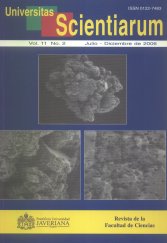Abstract
Se evaluaron 6 metodologías de conservación para hongos filamentosos con actividad enzimática amilolítica, bajo parámetros de viabilidad, pureza y actividad enzimática durante cuatro meses. Se utilizó para este trabajo la cepa nativa de Aspergillus niger SMB14M3 como microorganismo experimental por poseer actividad enzimática amilolítica amiloglucosidasa. La máxima actividad enzimática amilolítica atribuida a la amiloglucosidasa sobre la maltosa, se presentó a las 36 horas de fermentación, con un valor de 2.805 unidades (ìmol min-1 ml-1). El rango óptimo de actividad del extracto enzimático está en valores de pH que van desde 3 hasta 5 y 60°C de temperatura. Se evaluó la viabilidad del microorganismo conservado en diferentes métodos determinándose que los mejores son la conservación en agua destilada suplementada con NaCl al 0,85% y el suelo. No se observa que la pureza del microorganismo se vea afectada al igual que la actividad enzimática en el momento del uso experimental.Univ. Sci. is registered under a Creative Commons Attribution 4.0 International Public License. Thus, this work may be reproduced, distributed, and publicly shared in digital format, as long as the names of the authors and Pontificia Universidad Javeriana are acknowledged. Others are allowed to quote, adapt, transform, auto-archive, republish, and create based on this material, for any purpose (even commercial ones), provided the authorship is duly acknowledged, a link to the original work is provided, and it is specified if changes have been made. Pontificia Universidad Javeriana does not hold the rights of published works and the authors are solely responsible for the contents of their works; they keep the moral, intellectual, privacy, and publicity rights. Approving the intervention of the work (review, copy-editing, translation, layout) and the following outreach, are granted through an use license and not through an assignment of rights. This means the journal and Pontificia Universidad Javeriana cannot be held responsible for any ethical malpractice by the authors. As a consequence of the protection granted by the use license, the journal is not required to publish recantations or modify information already published, unless the errata stems from the editorial management process. Publishing contents in this journal does not generate royalties for contributors.



